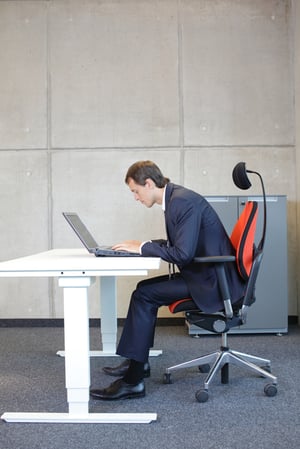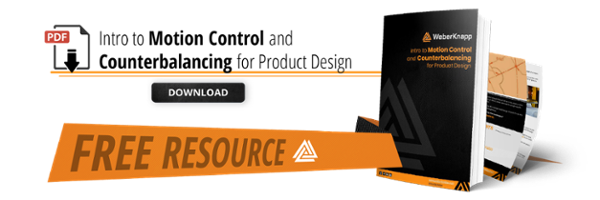Motion and perceived quality are closely linked. When a lid, cover, or door moves smoothly with just the “right” amount of effort, users can tell it's a high quality product.
The opposite is true, too -- if a hinged product violently swings and bangs around, it’s not only cheap, it’s also dangerous.
What's the difference between the two examples? Motion control. Here we'll answer the question, “What is motion control?” and explain how it relates to advanced hinge design. (Hint: There’s much more than we described in the example above.)
 What Is Motion Control?
What Is Motion Control?
Motion control is the process of having an object move through a desired path. It can involve linkages, pivots, mechanisms -- anything that helps your product get to an optimal position.
A door hinge is the most simple form of motion control. That basic pivot -- a pin through two metal loops -- provides rotation around the pin axis. It's how doors open and close.
Motion control solutions provide, as the words imply, control over the extent of travel. In conjunction with counterbalancing, you can also control the level of force required. (More on that below.)
Today, complex hinging has mastered motion control needs for several markets.
Benefits of Motion Control Through Hinge Design
Designers who incorporate motion control reap rewards in several areas of product performance:
- Ease of operation
- Improved ergonomics
- Increased safety
- Enhanced perception of quality
- Greater accessibility
- Aesthetics
Ease of Operation
When a door follows a particular path, it stays out of your way.
Or, in the case of French door oven handles, motion control is a matter of simple convenience. For example, you can pull on either door handle and have both doors open.
Safety
Being able to choose the path your door or lid keeps your user away from dangerous surfaces. Think again of the French door oven -- being able to open it from either side keeps a busy cook from having to reach across a steaming-hot oven door.
Another safety-minded motion control application is floor grates for running wires, etc. in buildings. You don’t want people tripping over those wires, so you hide them away with motion-controlled grates. As a bonus, you can add counterbalance hinges to make the grates easier to lift during repairs (again, more on counterbalancing below -- we promise).
Ergonomics
Thoughtful motion control design with hinges conserves the user’s body and energy level. If your product puts a strain on the users, they’ll be reluctant to use it (or recommend it to others).
If your product has a huge lid and someone short is trying to open it on their tippy-toes, you can bet she’s cursing your product under her breath. Vertically challenged folks can really benefit from a motion control component that puts the handle in a better position.
Perception
In some applications, such as a high-end French door oven, a steady, controlled opening implies quality. Your buyer opens it, feels a little resistance, and then it frees. When closing the fridge, there’s no slamming the doors to get it to seal.
Motion always looks better when it's smooth rather than sudden or jerky. Whether it's a cabinet door hinge or the lid of a heavy-duty toolbox, controlled motion suggests the designer cares about how the mechanism looks and works. It also implies the manufacturer puts performance ahead of cost control.
Accessibility
Motion control components can help you reach what you need to when you need to.
Say your customer has a filter in a ceiling that needs to be replaced. You’ll want a motion control device that drops and pulls back so the filter is serviceable.
Aesthetics
The previous example is relevant here, too. Motion control can keep that device housing your filter from crashing into adjacent cabinetry when you open the device.
Concealed or hidden hinges are also a blessing for sales and marketing teams who want to develop a good-looking product.
If you look at the top of a high-end refrigerator or freezer, chances are you won’t find a hinge. Motion control helps you keep nice, clean lines in your design -- or the room as a whole.
Counterbalance Hinges
Engineers have several potential goals when designing complex motion control components. Sometimes, they’re fighting gravity to reach those goals.
These complex hinging and motion control needs are often addressed through a counterbalance. Counterbalancing is just one element of motion control, but it’s a big one.
A counterbalance is a spring-based mechanism that reduces the effort needed to raise a lid or cover. Through careful selection of motion control components, a designer can set the force “felt” to whatever the end customer wants. Examples include smart countertops that lower down for people in wheelchairs as well as access doors and scientific equipment like centrifuges.
Weight can be a product design issue when the hinge pin is vertical, but it becomes a bigger problem when it's horizontal, like a chest freezer cabinet or a tanning bed door. In these scenarios, heavy base materials can make a device hard to open, and if released it crashes back down -- hopefully not on someone’s fingers.
Not everyone is a bodybuilder! Despite its heaviness, that tanning bed door should be manageable for a 16-year-old, 105-pound girl. What's more, it should stay open with either light or no support from the user, and must close in a very controlled manner.
It’s Not Just About Human Safety
Lids and doors that swing too fast or too far eventually sustain damage or damage other components. Controlling motion range, velocity, and acceleration reduces or even eliminates impact shock, preventing damage and extending equipment life.
Controlled deceleration is highly desired in appliance design, too. Instead of an appliance door slamming shut, complex hinge design lets it close with a satisfyingly smooth movement.
Note: Sometimes the counterbalance is separate from the actual hinge. If you’re already married to the hinge design-wise, your contract manufacturer may be able to add a counterbalance to your existing product.
Adding Value by Controlling Motion
There’s a hidden seventh benefit to using complex motion control in your new or existing product design: product differentiation.
Motion control solutions can seem complicated, but working with a complex hinge manufacturer early in the design phase can smooth the process out. A fresh look at your product design may be what you need to improve both actual and perceived value vs. your competitors’ offerings.
If you've never given motion control design much thought before, now is the time! It’s one of the most visually and functionally impressive ways to stand out from your competition.
(Editor's Note: This blog was originally written in May 2019 and was updated in June 2022.)
.png?width=12000&height=2033&name=WeberKnappLogo_white%20(1).png)

